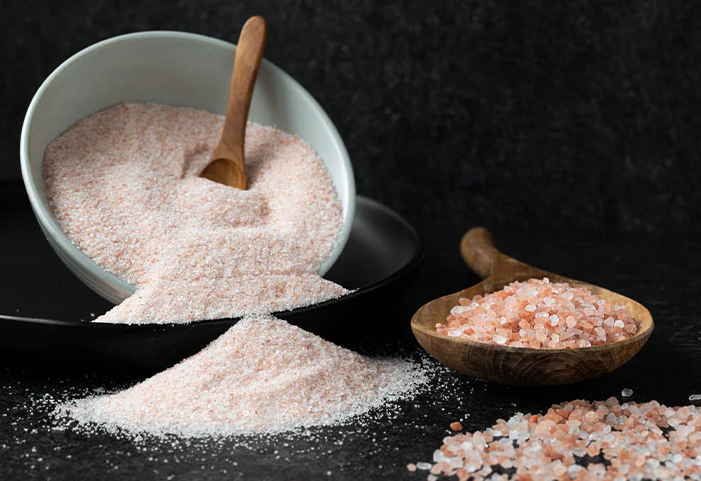Introduction:
If you’ve ever wondered, “What does Himalayan salt taste like?”, you’re not alone. As a popular alternative to regular table salt, Himalayan pink salt has gained recognition for its natural color, health benefits, and distinct taste. But what exactly makes its flavor different from traditional salts, and how can you use it in your cooking? In this article, we’ll break down the taste profile of Himalayan salt, explore its culinary applications, and even compare it to other types of salt to help you understand its unique flavor characteristics.
What is Himalayan Salt and Where Does it Come From?
Before diving into the flavor, let’s first understand where this salt comes from. Himalayan salt is harvested from ancient salt mines found in the Punjab region of Pakistan, near the foothills of the Himalayan Mountains. The salt is often touted as a “natural” salt because it has not been processed as heavily as regular table salt. Himalayan salt contains over 80 minerals and trace elements, which not only contribute to its health benefits but also to its taste.
The Appearance of Himalayan Salt
Himalayan salt’s distinctive pink color is due to the iron oxide content, along with various minerals. The color can range from a light pink to a deeper reddish hue. While the color might draw you in, its flavor is what truly sets it apart from other salts.
What Does Himalayan Salt Taste Like?
So, what does Himalayan salt taste like compared to your everyday salt? In short, it has a more subtle, complex flavor profile. While it is still salty, there’s a noticeable depth to it. Let’s break it down:
Mild Saltiness with Earthy Undertones
The taste of Himalayan salt is often described as less sharp and more mellow than regular salt. It offers a mild saltiness that isn’t overpowering, and this makes it an excellent choice for a variety of dishes. One of the reasons it’s so popular is because of its ability to enhance flavors without overwhelming them.
A Slightly Mineral Taste
Many people describe Himalayan salt as having a slight mineral taste, which comes from its high mineral content. These minerals, such as calcium, magnesium, and potassium, give the salt its complex, earthy undertones. It’s these subtle notes that set it apart from regular salt and make it a favorite among those who appreciate a more nuanced taste in their food.
How Does Himalayan Salt Compare to Other Types of Salt?
To better understand what Himalayan salt tastes like, it helps to compare it to other commonly used salts, such as sea salt and table salt. Here’s how they stack up:
Himalayan Salt vs. Table Salt
Table salt is typically more refined and can often taste sharper or saltier due to its higher sodium content and lack of minerals. It’s chemically processed, and sometimes additives like iodine are included. In contrast, Himalayan salt retains a more natural flavor, which many find to be smoother and less aggressive than table salt. The mineral content also adds a more layered taste.
Himalayan Salt vs. Sea Salt
Sea salt is another popular alternative to table salt, harvested from evaporated seawater. It tends to have a coarser texture and a briny, ocean-like flavor. Himalayan salt, while it shares some similarities with sea salt in terms of texture, has a more earthy and subtle flavor, largely due to its mineral content and origin.
Culinary Uses of Himalayan Salt
Now that we know what Himalayan salt tastes like, let’s explore how you can use it in your cooking.
Enhancing Flavor in Cooking
Because of its milder flavor, Himalayan salt is ideal for seasoning dishes where you want to enhance natural flavors without overpowering them. It pairs well with vegetables, meats, and even desserts. Some people enjoy using Himalayan salt for grilling steaks, where it adds depth to the flavor of the meat.
Cooking with Himalayan Salt Blocks
In addition to regular salt crystals, Himalayan salt blocks are another way to experience the salt’s unique flavor. These blocks can be used for grilling, searing, or even serving chilled foods. As the food interacts with the salt, it imparts a subtle mineral flavor that adds a gourmet touch.
Himalayan Salt in Drinks and Cocktails
Himalayan salt is also making its way into the world of beverages, including cocktails and water. Some people add a pinch of Himalayan salt to their water to boost hydration and enhance the flavor of the drink. It’s also used in margaritas and other cocktails to rim glasses, adding a slight mineral flavor to the drink.

Health Benefits of Himalayan Salt
In addition to its taste, Himalayan salt is believed to offer a variety of health benefits, which may make it even more appealing. It’s said to help with hydration, promote better digestion, and support the body’s electrolyte balance due to its mineral content.
Mineral Content and Health Impact
Himalayan salt contains over 80 minerals, including calcium, magnesium, potassium, and iron. These minerals are essential for the body’s health, and while you would need to consume a large amount to get significant benefits, using Himalayan salt in moderation can be a way to enhance your mineral intake naturally.
FAQ Section
- What does Himalayan salt taste like compared to table salt?
Himalayan salt has a more mild, earthy flavor, while table salt is sharper and saltier due to its refined nature. - Is Himalayan salt healthier than regular salt?
Himalayan salt contains trace minerals that may provide health benefits, but it’s still salt, so it should be consumed in moderation. - Can I use Himalayan salt in all my recipes?
Yes! Himalayan salt can be used in most recipes where you would normally use regular salt. It works especially well in grilling, seasoning vegetables, and even in desserts. - What is the best way to use Himalayan salt in cooking?
You can use it to season food, sprinkle it over dishes after cooking, or use it in cooking methods like grilling and baking on Himalayan salt blocks. - Does Himalayan salt taste different in different forms?
Yes, the flavor can change slightly depending on whether you’re using whole crystals, ground salt, or salt blocks. - Can Himalayan salt improve my health?
While the minerals in Himalayan salt are beneficial, the effects are mild, and it should be used as part of a balanced diet.
Conclusion:
Himalayan salt is much more than just a trendy alternative to table salt. Its subtle, earthy flavor and mineral-rich profile make it a versatile addition to any kitchen. Whether you’re using it to season a steak, rim a cocktail glass, or add depth to a dish, the distinct taste of Himalayan salt is one that can enhance the flavors of your food without overpowering them. Its health benefits are an added bonus, making it a natural choice for anyone looking to improve their diet while enjoying the unique flavors this salt provides.

